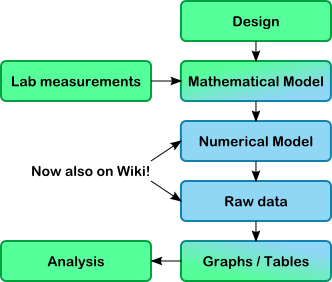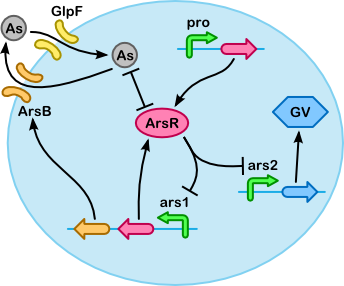Team:Groningen/Modelling
From 2009.igem.org
(Difference between revisions)
(Team:Groningen/Modelling moved to Team:Groningen/Modelling/Arsenic: Most of the page is specifically about arsenic.) |
m |
||
| (25 intermediate revisions not shown) | |||
| Line 1: | Line 1: | ||
| - | # | + | {{Team:Groningen/Modelling/Header}} |
| + | <div style="clear:both;"></div> | ||
| + | <div style="float:left" >{{linkedImage|GroningenPrevious.png|Team:Groningen/Project/Vesicle}}</div> | ||
| + | <div title="Arsie Says UP TO ACCUMULATION" style="float:right;" >{{linkedImage|Next.JPG|Team:Groningen/Modelling/Arsenic}}</div> | ||
| + | [[Category:Team:Groningen/Disciplines/Analysis_and_Design|Modelling]] | ||
| + | [[Category:Team:Groningen/Roles/Modeller|Modelling]] | ||
| + | <html><style type="text/css"> | ||
| + | .intro { margin-left:0px; margin-top:10px; padding:10px; border-left:solid 5px #FFF6D5; border-right:solid 5px #FFF6D5; text-align:justify;background:#FFFFE5; } | ||
| + | </style></html> | ||
| + | <div class="intro introduction"> | ||
| + | ==Introduction== | ||
| + | [[Image:Modelling.png|frame|right|<span style="font-weight:normal;">Normally the design and analysis is done/documented on the wiki, and even lab measurements/protocols are in the Notebook. This is in contrast to most of the artifacts related to modelling (SBML files, data sheets, etc.). To make our models more accessible and an integral part of our project we put the entire modelling workflow on-line. For one thing, this makes it easier to '''explore''' the model, up to the point that even non-modellers are able to explore the model.</span>]] | ||
| + | Modelling is an integral part of synthetic biology and most of our modelling results are therefore integrated with our theoretical information and lab results on our [[Team:Groningen/Project|project pages]]. In general we have tried to make as much of our model as possible ''interactively'' available on our wiki. Specifically, we have constructed several interactive calculators that can be used to explore our model, some including interactive [https://2009.igem.org/Template:Graph graphs] to show the results. | ||
| + | </div> | ||
| + | |||
| + | In our project we use modelling for the following purposes: | ||
| + | |||
| + | *'''Description''' of our system. By modelling the system the different relationships between components in our system are made explicit. | ||
| + | *'''Gaining insight''' in our system. Having modelled our system we can see how different variables interact, giving essential insights into how our system functions. | ||
| + | *'''Verification''' of our design. For example, we looked at the number of gas vesicles needed to let our cells float, to check whether it should be possible. | ||
| + | *'''Making design choices'''. We have shown that constitutive expression of ArsR can indeed significantly increase accumulation levels, and we would be able to show the impact of this constitutively expressed ArsR regulating the ars promoter on the expression of the GVP cluster (see [[Team:Groningen/Project/Promoters#Modelling|our promoter modelling]]). | ||
| + | *'''Designing tests'''. By looking at the behaviour of GlpF/ArsB (importer/exporter for As(III)) we determined what range of concentrations would be interesting to use in our uptake experiments. | ||
| + | *'''Analysis''' of results. Using data from uptake experiments, promoter measurements and TEM pictures we can [[Team:Groningen/Modelling/Characterization|estimate further constants]] and/or explain the results. | ||
| + | |||
| + | Our initial ideas on how and what to model (including a survey of previously used software) can be found at [[Team:Groningen/Brainstorm/Modelling|Brainstorm/Modelling]]. | ||
| + | |||
| + | ==Models== | ||
| + | Our modelling results can be viewed on our project pages, including our '''interactive''' calculators and graphs: | ||
| + | <html><style> | ||
| + | /* Based on http://matthewjamestaylor.com/blog/beautiful-css-centered-menus-no-hacks-full-cross-browser-support */ | ||
| + | .subprojects { float:left; width:100%; overflow:hidden; position:relative; } | ||
| + | .subprojects ul { clear:left; float:left; list-style:none; margin:0; padding:0; position:relative; left:50%; text-align:center; } | ||
| + | .subprojects li { display:block; float:left; list-style:none; margin:0; position:relative; right:50%; | ||
| + | padding:5px 169px 5px 5px; height:79px; text-indent:-9999px; | ||
| + | background-repeat: no-repeat; background-position: center center; } | ||
| + | .subprojects li+li { border-left: solid 2px #81d1f1; } | ||
| + | .subprojects a { text-indent:-9999px; display:block; width:164px; height:79px; background-repeat: no-repeat; background-position: center center; position:absolute; left:5px; top:5px; } | ||
| + | .subprojects ul li a:hover { background:none; } | ||
| + | .subprojects .transport { background-image:url('/wiki/images/e/ea/PSTransport.png'); } | ||
| + | .subprojects .accumulation { background-image:url('/wiki/images/9/9a/PSAccumulation.png'); } | ||
| + | .subprojects .promoters { background-image:url('/wiki/images/4/4e/PSPromoter.png'); } | ||
| + | .subprojects .vesicles { background-image:url('/wiki/images/8/80/PSVesicles.png'); } | ||
| + | .subprojects .transport a { background-image:url('/wiki/images/c/c2/PSTransportLightW.png'); } | ||
| + | .subprojects .accumulation a { background-image:url('/wiki/images/c/c8/PSAccumulationLightW.png'); } | ||
| + | .subprojects .promoters a { background-image:url('/wiki/images/1/16/PSPromoterLightW.png'); } | ||
| + | .subprojects .vesicles a { background-image:url('/wiki/images/9/99/PSVesiclesLightW.png'); } | ||
| + | </style> | ||
| + | <div class="subprojects"> | ||
| + | <ul> | ||
| + | <li class="transport"></html>[[Team:Groningen/Project/Transport#Modelling|Transport]]<html></li> | ||
| + | <li class="accumulation"></html>[[Team:Groningen/Project/Accumulation#Modelling|Accumulation]]<html></li> | ||
| + | <li class="promoters"></html>[[Team:Groningen/Project/Promoters#Modelling|Metal-sensitive Promoters]]<html></li> | ||
| + | <li class="vesicles"></html>[[Team:Groningen/Project/Vesicle#Modelling|Gas Vesicles]]<html></li> | ||
| + | </ul> | ||
| + | </div> | ||
| + | </html> | ||
| + | Most of the modelling sections are based on our ODE model: | ||
| + | |||
| + | <center>{{LinkedImage|Arsenic_filtering.png|Team:Groningen/Modelling/Arsenic}}<br/>(Click to go to our detailed [[Team:Groningen/Modelling/Arsenic|modelling page]].)</center> | ||
| + | |||
| + | <!--==Michaelis-Menten revisited== | ||
| + | By simplifying the model it is possible to reduce the number of parameters of the model, often making it easier to find reasonable values for the parameters. One popular way of simplifying a model is by using the [[Team:Groningen/Glossary#MichaelisMenten|Michaelis-Menten]] equation, or something similar, like the Hill equation. This type of simplification uses some assumptions to reduce a recurring reaction motif to one reaction involving a more complicated rate equation. | ||
| + | |||
| + | {{todo|Explain what we did instead.}}--> | ||
| + | |||
| + | <!--== Kinetic Laws == | ||
| + | {{todo}} Add references. | ||
| + | |||
| + | {{todo}} Find out how to determine experimentally which is applicable (and if you know, what the parameters are). | ||
| + | |||
| + | ;Mass Action | ||
| + | :Molecules randomly interact, the reaction rate is simply the product of the concentrations of the reactants (multiplied by a constant). | ||
| + | ;Michaelis-Menten | ||
| + | :Applicable to situations where there is a maximum reaction rate (due to needing a catalyst/transporter/binding site of which there is only a limited amount for example) under the assumption that there is much more of the "main" reactant than of the catalyst/transporter. Has two constants, the maximum reaction ''rate'' and the concentration at which the reaction rate is half the maximum reaction rate. | ||
| + | ;Michaelis-Menten reversible | ||
| + | :{{todo}} | ||
| + | ;Hill | ||
| + | :Generalization of Michaelis-Menten. {{todo|More detail.}} | ||
| + | |||
| + | For rate parameters it is best to have both the forward and reverse reaction rates, if you don't then a dissociation constant can be used (which is the ratio of the reverse and forward rates), in combination with a "standard" rate of 10<sup>8</sup>-10<sup>9</sup> (see appendix A of [[Team:Groningen/Literature#Alon2007|Alon2007]]), in the case of two reactants at least. | ||
| + | |||
| + | See http://www.biomodels.net/ for a database of models. | ||
| + | --> | ||
| + | {{Team:Groningen/Footer}} | ||
Latest revision as of 20:47, 21 October 2009
Modelling
|
|---|
- Modelling
- DetailedModel
- Characterization
- Downloads
Introduction

Normally the design and analysis is done/documented on the wiki, and even lab measurements/protocols are in the Notebook. This is in contrast to most of the artifacts related to modelling (SBML files, data sheets, etc.). To make our models more accessible and an integral part of our project we put the entire modelling workflow on-line. For one thing, this makes it easier to explore the model, up to the point that even non-modellers are able to explore the model.
Modelling is an integral part of synthetic biology and most of our modelling results are therefore integrated with our theoretical information and lab results on our project pages. In general we have tried to make as much of our model as possible interactively available on our wiki. Specifically, we have constructed several interactive calculators that can be used to explore our model, some including interactive graphs to show the results.
In our project we use modelling for the following purposes:
- Description of our system. By modelling the system the different relationships between components in our system are made explicit.
- Gaining insight in our system. Having modelled our system we can see how different variables interact, giving essential insights into how our system functions.
- Verification of our design. For example, we looked at the number of gas vesicles needed to let our cells float, to check whether it should be possible.
- Making design choices. We have shown that constitutive expression of ArsR can indeed significantly increase accumulation levels, and we would be able to show the impact of this constitutively expressed ArsR regulating the ars promoter on the expression of the GVP cluster (see our promoter modelling).
- Designing tests. By looking at the behaviour of GlpF/ArsB (importer/exporter for As(III)) we determined what range of concentrations would be interesting to use in our uptake experiments.
- Analysis of results. Using data from uptake experiments, promoter measurements and TEM pictures we can estimate further constants and/or explain the results.
Our initial ideas on how and what to model (including a survey of previously used software) can be found at Brainstorm/Modelling.
Models
Our modelling results can be viewed on our project pages, including our interactive calculators and graphs:
Most of the modelling sections are based on our ODE model:
(Click to go to our detailed modelling page.)
 "
"









